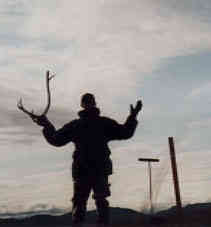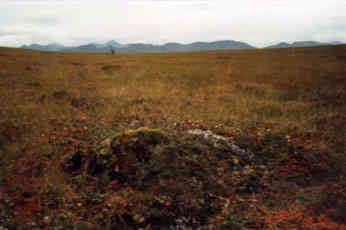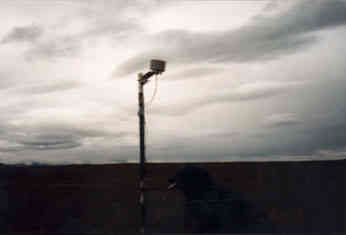13 August, 1998
August 13, 1998
Imnavait Creek Site, Entering Data
Today we got our first taste of actual research in the field. We went to
Imnavait Creek and learned how to probe active layer depth. The active
layer is the seasonally frozen ground that is right above the permafrost.
To measure its depth you need to shove a metal probe into the ground until
you hit something very solid, then determine if it is a rock or the
permafrost. When you hit the permafrost it gives a little, just like
chipping ice. The active layer depth also varies quite a bit throughout
the one kilometer square area we checked. Anywhere from 29 cm. to 110 cm.
in places. The average depth of the active layer at Imnavait was 56.5 cm.
Walking on the tundra is much different than walking anywhere else. The
tussocks and other plants make moving in a straight line very difficult. I
think it is like walking in a boulder field that is covered in varying
thicknesses of foam padding. The foam padding of the tundra is the decayed
and decaying organic material from centuries past. This peat is just like
a sponge also. It soaks up incredible amounts of water and lets it loose
when you step on it. I am really glad to have my rubber boots.
Returning to the lab, we had to transfer the field data into a master log
book and then enter it into the computer. This is the drudgery of the
research. In the field, you get to move around and be active. In the lab
you get to sit and get bogged down by large amounts of data. I definitely
like the field better, even though every bone in my body seems to be
aching. Tomorrow we will go to Happy Valley, but from the sound of it may
not be the happiest place on earth (I hope Disney doesn't get too mad that
I used their copyrighted slogan - that would really infuriate the duck). MYM
JAVIER'S PIECE
My first experience of field work on the Northern Slope. Even though the
valley where Imnavait was seemed small, the dimension of depth was very
misleading. It took about 30 minutes to travel from one end of the grid to
the other: and it's only a kilometer. At the very top of the grid, where I
was, I could see for about five miles onto the next valley and river and
across to the pipeline. Just the vastness and repetition of wildlife here
was amazing. While I was up at my section of the grid, I found the one of
the antlers from some female caribou. Nothing like this would ever be
found near my home.
In my measurements, I also realized that the active layer of the tundra at
the river basin was far more uniform than the depth of the active layer at
the slopes of the mountains. Tomorrow, we will go to Happy Valley and
hopefully, I'll be able to take some pictures of a bear at great distances,
for security reasons, of course.

Javier sports Imnavait Creek treasures (note probe and grid marker next to him! [photo by Javier Lopez]).

Hummock at Imnavait Creek (Jim Bockheim in background near mast [photo by Javier Lopez]).

Anna replacing batteries at one of the LAII Flux Study plots by Imnavait Creek (photo by Javier Lopez).
Contact the TEA in the field at
.
If you cannot connect through your browser, copy the
TEA's e-mail address in the "To:" line of
your favorite e-mail package.
|
